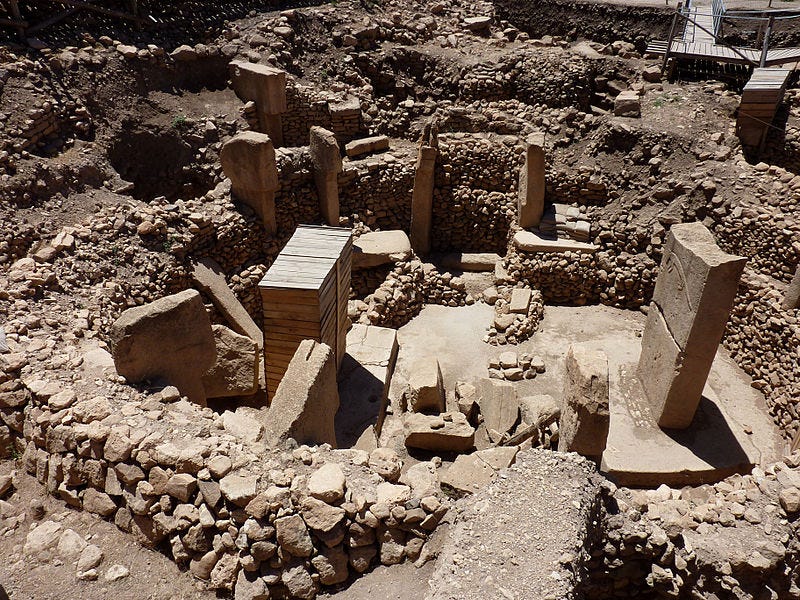Ancient Temples: How Religion Preceded Agriculture in Civilization
Written on
Chapter 1: The Discovery of Göbekli Tepe
In 1994, archaeologist Klaus Schmidt turned his attention to a notable hilltop mound in Turkey while researching prehistoric sites. His interest was piqued by a report from the University of Chicago and the University of Istanbul, which had previously dismissed the site as a medieval cemetery based on broken limestone slabs.
Upon further excavation, Schmidt unearthed what is regarded as one of the most significant prehistoric finds in modern history, fundamentally altering our perceptions of early human civilization.
This site, known as Göbekli Tepe, translates to "pot-bellied hill." The limestone slabs date back thousands of years, far earlier than the medieval period.
Imagine the oldest structures you can envision: the pyramids or Stonehenge. Remarkably, Göbekli Tepe predates these monuments by over 11,000 years, created by hunter-gatherers as a sacred place of worship. This challenges the conventional belief that such religious edifices were erected only after societies had settled and achieved food security.
Why would these ancient people construct a temple prior to mastering agriculture and animal husbandry? To explore this question, we must delve into the history of Göbekli Tepe and its builders.
Section 1.1: Who Constructed Göbekli Tepe?
Situated just north of the Fertile Crescent in modern Turkey, the construction of Göbekli Tepe began before 9500 B.C., well ahead of the advent of farming in the area. At this time, pottery had not yet been developed, indicating that hunter-gatherers equipped with only stone tools were responsible for the construction.
Large T-shaped limestone pillars, some reaching heights of 5 meters (16 feet) and weighing an average of 10 tons, are scattered throughout the site. The largest stone weighs approximately 16 tons! The methods by which these enormous slabs were transported remain a mystery, but it's evident that a large workforce was involved.
The builders etched intricate designs of wild animals and geometric patterns into the stones. Schmidt theorized that these motifs might represent totems, all depicting male animals for reasons still unknown.

Among the animals depicted on the pillars are foxes, cranes, lizards, boars, vultures, and scorpions, with foxes and snakes being the most prevalent. The prominence of foxes may relate to their significance in shamanic traditions. Around 10,000 B.C., the region's environment was vastly different, leading researchers to believe that the carvings reflect the flora and fauna of that time.
The pillars also feature representations of human anatomy, suggesting that they may honor the deceased. Archaeologists discovered several human skulls at the site, some of which show signs of being carved post-mortem.
Construction of the temple spanned from approximately 9500 B.C. to 8000 B.C. Following this period, the site was intentionally filled with animal bones, which were likely discarded debris rather than holding any religious significance.
Göbekli Tepe was not a residential site; however, a cistern for rainwater collection indicates that various hunter-gatherer groups utilized it for religious ceremonies. Analysis of animal bones from this era reveals that the inhabitants consumed choice cuts of meat, implying that the animals were slaughtered elsewhere, prepared, and then offered at this sacred site.
Section 1.2: The Role of Religion in Prehistoric Societies
Religion existed within hunter-gatherer communities long before the construction of Göbekli Tepe. However, a significant distinction arises when comparing a simple shamanistic ritual to the extensive labor and resources required to create a sophisticated place of worship.
Questions arise: How did they sustain the workforce? What were the logistics for maintenance and feasting? Any answers remain speculative due to the absence of written records. Nonetheless, certain actions observed at Göbekli Tepe align with practices associated with much later periods.
This indicates that these communities had access to sufficient food derived from hunting and foraging, placing them on the brink of agricultural discovery. Following the temple's completion, hunter-gatherers may have transitioned towards farming to sustain those involved in its construction and rituals.
Could the act of building a temple have spurred the development of agriculture? Such a theory flips the narrative that complex constructions arose solely from the availability of food. Instead, it suggests a division of labor that encouraged more individuals to engage in farming, thereby facilitating construction and subsequent trade.
This idea resonates with early Bronze Age cultures, where agricultural guidance originated from city palaces, driven by priest-kings who dictated crop types and irrigation methods. Civilizations thrived in fertile river valleys, while nomadic groups retained their lifestyles until they encountered and were influenced by established societies.
The Mongols, for instance, were nomadic and generally opposed to agriculture. Genghis Khan, a figure known for his military conquests, only entered one city, Bukhara, throughout his life, reflecting his disdain for urban living. By the time his son, Ogedei, assumed leadership, Mongol raids had evolved into more luxurious lifestyles.
This shift necessitated a stable food supply to support burgeoning populations and protect new constructions. The challenge remains: could large-scale building initiatives have driven agricultural advancements? While we cannot definitively conclude this, it is a theory worthy of consideration.
Göbekli Tepe's construction without metal tools raises questions about the ingenuity of hunter-gatherers. Ongoing discoveries at this site and others will continue to reshape our understanding of human history.
Chapter 2: The Impact of Göbekli Tepe on Civilization
The first video, "The Oldest Religion in the World: The Origin of Belief," delves into the development of early religious practices and their implications on human society.
The second video, "The Underground Religion of Neolithic Italy - European Prehistory," explores how religious beliefs influenced Neolithic cultures, further illustrating the interconnectedness of faith and societal development.
As we continue to analyze Göbekli Tepe, we recognize the transformative role that religion played in shaping human civilization, arguably as critical as food itself, and its potential to redirect the course of history. This remarkable site serves as the precursor to proto-cities and signifies the emergence of complex societal structures. For those intrigued by the origins of ancient cities, further exploration awaits.